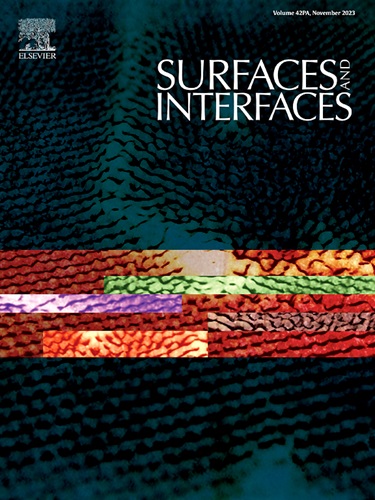添加剂(KF, KI)对LiCl-KCl体系中铁的成核机理和沉积产物形貌的影响
IF 5.7
2区 材料科学
Q2 CHEMISTRY, PHYSICAL
引用次数: 0
摘要
本文采用电化学技术研究了添加剂(KF和KI)对LiCl-KCl熔盐中Fe(II)的还原/成核机理和镀层形貌的影响。结果发现,随着F−或I−的不断增加,Fe的沉积电位略微向负方向偏移,作用机制不同。用时间电流法分析了不同添加剂(KI和KF)下铁的成核机制,发现其为瞬时成核。对原子核密度进行了估算,结果表明,在相同条件下,加入F−后的Fe原子核密度略大于加入I−后的Fe原子核密度。此外,通过在LiCl-KCl熔盐中加入不同的添加剂,进行了恒电位电解。XRD结果表明,Fe涂层的形成。计算了添加添加剂前后铁的织构系数,发现其基本保持不变。通过SEM-EDS和LSM对不同添加剂制备的Fe涂层的表面形貌、粗糙度和厚度进行了比较,结果表明,加入F−或I−后,产品表面形貌由块状颗粒变为球形聚集体或更大的多面体。粗糙度分别为0.970 μm、0.840 μm (CF−/CFe(II)=4)和0.801 μm (CI−/CFe(II)=4);厚度分别为51.8 μm、47.8 μm (CF−/CFe(II)=4)和48.5 μm (CI−/CFe(II)=4)。本文章由计算机程序翻译,如有差异,请以英文原文为准。
Effect of additives (KF, KI) on nucleation mechanism and morphology of deposited products of Fe in LiCl-KCl system
In this work, the effects of additives (KF and KI) on the reduction/nucleation mechanism of Fe(II) and the morphology of the deposits were investigated in LiCl-KCl molten salt using electrochemical techniques. It was found that with the continuous increase of F− or I−, the deposition potential of Fe shifted slightly towards the negative direction, and the mechanism of action was different. The nucleation mechanism of Fe under different additives (KI and KF) was analyzed using chronoamperometry, and found to be instantaneous nucleation. The nucleus density was estimated, indicating that under the same conditions, the nucleus density of Fe after adding F− was slight larger than that after adding I−. Additionally, Potentiostatic electrolysis was carried out by adding different additives to LiCl-KCl molten salt. XRD results showed the formation of Fe coatings. The texture coefficients of Fe before and after adding the additives were calculated, showing that they remained basically unchanged. The surface morphology, roughness and thickness of Fe coatings prepared with different additives were compared by SEM-EDS and LSM, which illustrated that after the addition of F− or I−, the surface morphology of the products changed from blocky particles to spherical aggregates or larger polyhedrons. The roughness was 0.970 μm, 0.840 μm (=4), and 0.801 μm (=4); and the thickness was(51.8 μm, 47.8 μm (=4), and 48.5 μm (=4), respectively.
求助全文
通过发布文献求助,成功后即可免费获取论文全文。
去求助
来源期刊

Surfaces and Interfaces
Chemistry-General Chemistry
CiteScore
8.50
自引率
6.50%
发文量
753
审稿时长
35 days
期刊介绍:
The aim of the journal is to provide a respectful outlet for ''sound science'' papers in all research areas on surfaces and interfaces. We define sound science papers as papers that describe new and well-executed research, but that do not necessarily provide brand new insights or are merely a description of research results.
Surfaces and Interfaces publishes research papers in all fields of surface science which may not always find the right home on first submission to our Elsevier sister journals (Applied Surface, Surface and Coatings Technology, Thin Solid Films)
 求助内容:
求助内容: 应助结果提醒方式:
应助结果提醒方式:


